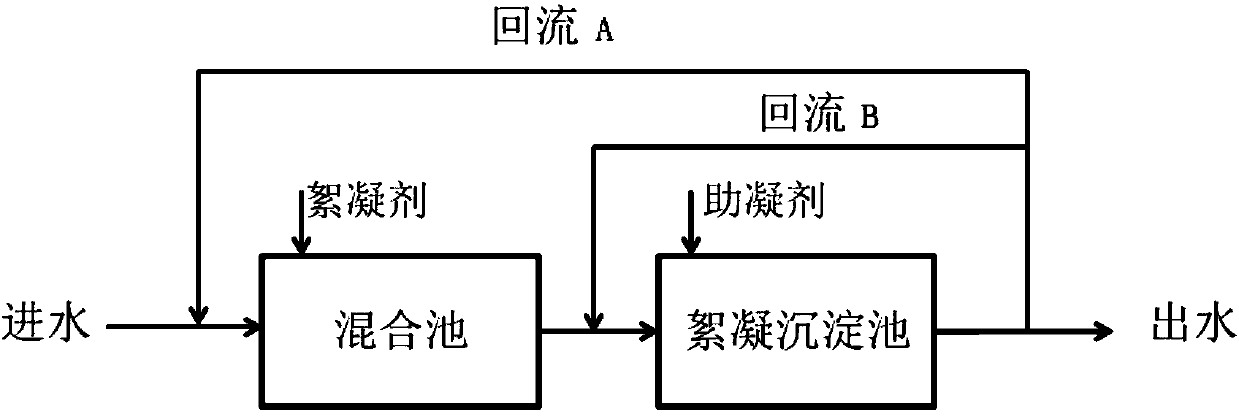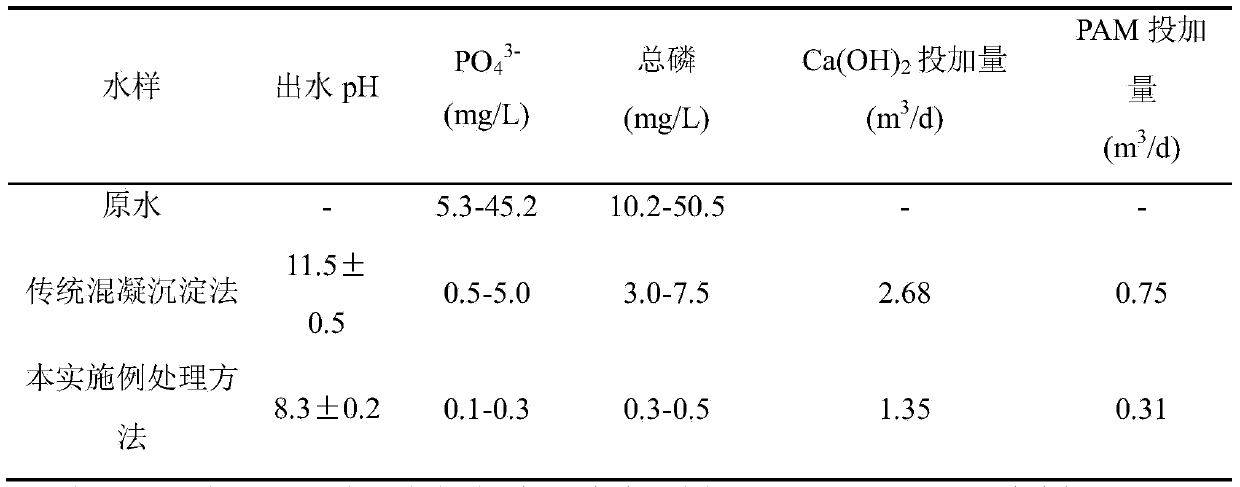Sewage treatment method based on supernatant reflux of flocculation settling tank
A sewage treatment method and sedimentation tank technology, which are applied in the direction of flocculation/sedimentation water/sewage treatment, etc., can solve the problems of ineffective use of chemicals, large fluctuations in water quality and water quantity, and waste of dosage of chemicals, and are conducive to stability. The effect of meeting the standards, reducing comprehensive operating costs and reducing adverse impacts
- Summary
- Abstract
- Description
- Claims
- Application Information
AI Technical Summary
Problems solved by technology
Method used
Image
Examples
Embodiment 1
[0033] Taking the treatment of phosphorus-containing sewage in an industry as an example, the sewage treatment capacity is 300m 3 / d, the total phosphorus concentration is 10.2mg / L-50.5mg / L.
[0034] Such as figure 1 As shown, the traditional coagulation-sedimentation reaction to the wastewater treatment process is: add 10% Ca(OH) in the mixing tank2 (calcium hydroxide) mixed reaction, in order to ensure that phosphorus can be completely removed, Ca(OH) 2 The dosage is 2.68m 3 / d; the fully mixed effluent enters the flocculation sedimentation tank, and polyacrylamide (PAM) with a mass percentage of 1‰ is added to the flocculation sedimentation tank for flocculation and precipitation reaction. The dosage of polyacrylamide (PAM) is 0.75m 3 / d. After standing still for 90min to precipitate, the supernatant was discharged after adjusting the pH.
[0035] Such as figure 2 As shown, a kind of sewage treatment method based on the reflux of the supernatant of the flocculation se...
Embodiment 2
[0046] Taking the waste water of a printing and dyeing enterprise as an example, its sewage treatment capacity is 100m 3 / d, the COD (chemical oxygen demand) concentration is 3000-5000mg / L, the SS is 500-1000mg / L, and the chromaticity is 6000-10000 times.
[0047] Such as figure 1 As shown, the traditional coagulation-sedimentation method is used for pretreatment, and the specific treatment process is the same as in Example 1, except that the dosage of flocculant polyaluminum chloride (PAC) is 0.4m 3 / d, its mass percentage is 5%, and the dosage of coagulant aid PAM is 0.4m 3 / d, the mass percentage is 0.5‰, after standing for 120 minutes, the supernatant enters the next processing unit for processing.
[0048] Such as figure 2 As shown, a kind of sewage treatment method based on the reflux of the supernatant of the flocculation sedimentation tank of the present embodiment can treat the sewage of the same type and the same treatment capacity. With the waste water of a cert...
Embodiment 3
[0059] Taking a certain slaughtering wastewater as an example, its sewage treatment capacity is 500m 3 / d, COD concentration is 700-1000mg / L, SS is 400-700mg / L.
[0060] Such as figure 1 As shown, the traditional coagulation sedimentation method is used for pretreatment, and the specific treatment process is the same as in Example 2, the difference is that the dosage of flocculant polyferric sulfate (PFS) is 0.75m 3 / d, its mass percentage is 20%; polyvinylpyrene salt is used as coagulant aid, and the dosage is 0.75m 3 / d, the mass ratio is 2‰, after standing for 90 minutes, the supernatant enters the next processing unit for processing.
[0061] Such as figure 2 As shown, a sewage treatment method based on the reflux of the supernatant of the flocculation sedimentation tank in this embodiment is used to treat the same type of sewage with the same treatment capacity, that is, a certain slaughtering wastewater. The steps are:
[0062] (1) Flow the sewage to be treated int...
PUM
| Property | Measurement | Unit |
|---|---|---|
| concentration | aaaaa | aaaaa |
Abstract
Description
Claims
Application Information
 Login to View More
Login to View More - R&D
- Intellectual Property
- Life Sciences
- Materials
- Tech Scout
- Unparalleled Data Quality
- Higher Quality Content
- 60% Fewer Hallucinations
Browse by: Latest US Patents, China's latest patents, Technical Efficacy Thesaurus, Application Domain, Technology Topic, Popular Technical Reports.
© 2025 PatSnap. All rights reserved.Legal|Privacy policy|Modern Slavery Act Transparency Statement|Sitemap|About US| Contact US: help@patsnap.com



